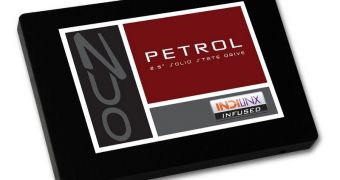Even as the holidays are closing in, OCZ decided to stealthily bring out some new solid state drives, possibly expecting increased demand because of the HDD shortages.
Not that such expectations would be unwarranted, of course, since there really are, or will be, real shortages of platter spinners.
Analysts even said PC sales would be affected (millions less will ship in early 2012).
With that to reduce the HDD/SSD price gap, the latter could very well sell better, especially if they sacrifice some performance in favor of affordability.
Trading performance for lower prices is precisely what the Octane Petrol do, or will do as soon as their prices reach their final state.
Since only early listings can be found online, the tags are a bit higher than they should or will be.
That said, there are four drives, with capacities of 64 GB, 128 GB, 256 GB and 512 GB, respectively.
In that order, users will have to fork up $113 (84.50 Euro), $187 (139.84 Euro), $396 (296.14 Euro) and $803 (600.50 Euro).
All Petrol models have 2xnm asynchronous MLC (multi-level cell) NAND Flash memory chips and the SATA 6.0 Gbps interface.
Their read and write speeds vary depending on capacity, where bigger is faster, but the top limit is of 370 MB/s when reading and 250 MB/s when writing.
Had OCZ used SandForce controllers, the numbers would have been over 500 MB/s, but Indilinx Everest chips are used instead.
Other specifications of the 2.5-inch OCZ Octane Petrol SSDs include TRIM support (lets Windows 7 preserve performance over time by constantly cleaning up deleted data), MTBF of 1.25 million hours and the NDurance technology (doubles product lifespan).
Anyone who wants the best of the crop might want to check out the significantly faster Super Talent TeraNova SATA 3 SSDs instead (SandForce, SATA 3, 60 to 480 GB capacity) or OCZ's Own Talos 2 (even if they are more enterprise-oriented).

 14 DAY TRIAL //
14 DAY TRIAL //